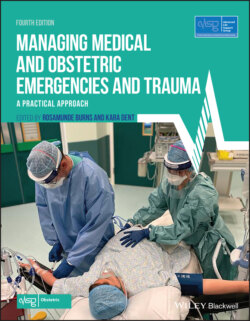Читать книгу Managing Medical and Obstetric Emergencies and Trauma - Группа авторов - Страница 19
ОглавлениеCHAPTER 1 Introduction
Throughout both the developed and the developing world, maternal mortality continues to present a serious challenge. Globally, there is estimated to be one maternal death every minute. This course will provide you with a system for managing the seriously ill and seriously injured pregnant woman. The system is designed to be simple and easy to remember when life‐threatening emergencies arise and is known as the structured approach.
The structured approach is based on the ABC of resuscitation and is practised throughout all areas of medicine and the emergency services. The concept is familiar to the lay person and known even to school children. This structured approach has led to the development of courses that attend to the resuscitation needs of all patients, from neonates to children, adults and women with the altered physiology and anatomy of pregnancy.
This manual, Managing Medical and Obstetric Emergencies and Trauma (mMOET), online material and the practical course are divided into sections that provide a structured revision in recognition, resuscitation and treatment of emergencies in pregnancy. This includes trauma, medical and surgical emergencies and obstetric emergencies and is aimed at obstetricians, anaesthetists, emergency and other physicians, and midwives. The structured approach is applied to resuscitation and is taught didactically as a drill. Subsequently, what has been learned is applied to both the recognition and management of the seriously ill and injured pregnant patient.
The physiological adjustments of pregnancy affect the response of the mother to illness and injury. These changes mean that resuscitation should be tailored to the pregnant patient and this manual, and the mMOET course, teaches how this is achieved.
The Managing Obstetric Emergencies and Trauma (MOET) course began in 2001 and runs under the auspices of the Advanced Life Support Group (ALSG). Its aim is to provide the knowledge, practical skills and procedures necessary to save the mother and fetus in life‐threatening circumstances. The course runs in six countries and, since its inception, over 8380 providers and 720 instructors have been trained. Course information and links for candidates and faculty are available from the ALSG website (www.alsg.org).
Recent catastrophic traumatic events including terrorist attacks and major fires have heightened awareness of the need for expanding trauma education amongst the obstetric community. To date trauma management has not been widely taught to obstetricians, but when trauma does occur to pregnant women those in other specialties will consider the obstetrician the expert when managing them.
The importance of serious medical co‐morbidities within the pregnant population contributing to maternal death and the need for early recognition of the seriously ill pregnant woman has been emphasised in confidential mortality reports, and this has resulted in a particular new focus for MOET teaching: we now call the course mMOET – managing Medical and Obstetric Emergencies and Trauma to reflect this.
This text is essential pre‐course reading for the mMOET course and also provides a valuable reference for all healthcare workers involved in caring for pregnant women.
In more recent years, and in acknowledgement of the challenging study leave climate in the UK, a pre‐course online learning component (Box 1.1) was devised, piloted and widely introduced to supplement the manual and the face‐to‐face material (www.alsg.org/vle). This continues to be updated and aims to reinforce the current text and provides an interactive method of delivering the knowledge components of the course. It prepares participants for the practical application of knowledge during the face‐to‐face course.
Box 1.1 Content of the mMOET online learning package
Structured approach
CPR, resuscitation and perimortem CS
Airway management and breathing
Trauma
Massive obstetric haemorrhage
Complications of delivery
Hypertensive disease of pregnancy
Neurological emergencies
Diabetic emergencies
Cardiac emergencies
Sepsis
Neonatal resuscitation
Local anaesthesia
Postnatal depression and vulnerabilities
Human factors
The face‐to‐face course offers participants the opportunity to further reinforce their pre‐course learning and also to have hands‐on practise of essential skills. Lectures, interactive sessions, demonstrations and workshops explore a variety of emergencies including obstetric and trauma, but increasingly focus on the acute medical emergencies identified as the leading causes of deaths of pregnant women in the confidential mortality reports by MBRRACE‐UK (Mothers and Babies: Reducing Risk through Audit and Confidential Enquiries across the UK; previously Centre for Maternal and Child Enquiries (CMACE) or Confidential Enquiries into Maternal Deaths (CEMD)). Simulations, discussions and skills practise allow candidates to put knowledge and skills together and to practise and learn within a safe environment. In this, they are supported with structured debriefing by instructors and their fellow candidates. Continuous assessment indicates those candidates that have achieved the required standard to be a ‘mMOET provider’, a status which lasts for 4 years.
Those candidates who demonstrate the potential to be an instructor are invited to undertake a structured training programme. The Generic Instructor Course (GIC) prepares instructors to deliver lectures, skills teaching, small group discussions, simulations and also to carry out assessments. This is reinforced with support and assessment by experienced instructors when new instructors teach on mMOET courses on the first two occasions. Instructors then teach on three courses over each 2‐year period to maintain their status.
As priorities for training change, the mMOET course is continually improved following feedback from course directors, instructors and candidates and from important trend information from major reports, for example MBRRACE and UK Obstetric Surveillance System (UKOSS). This ensures that it remains fit for purpose and focuses on the current leading causes of maternal mortality and morbidity.
